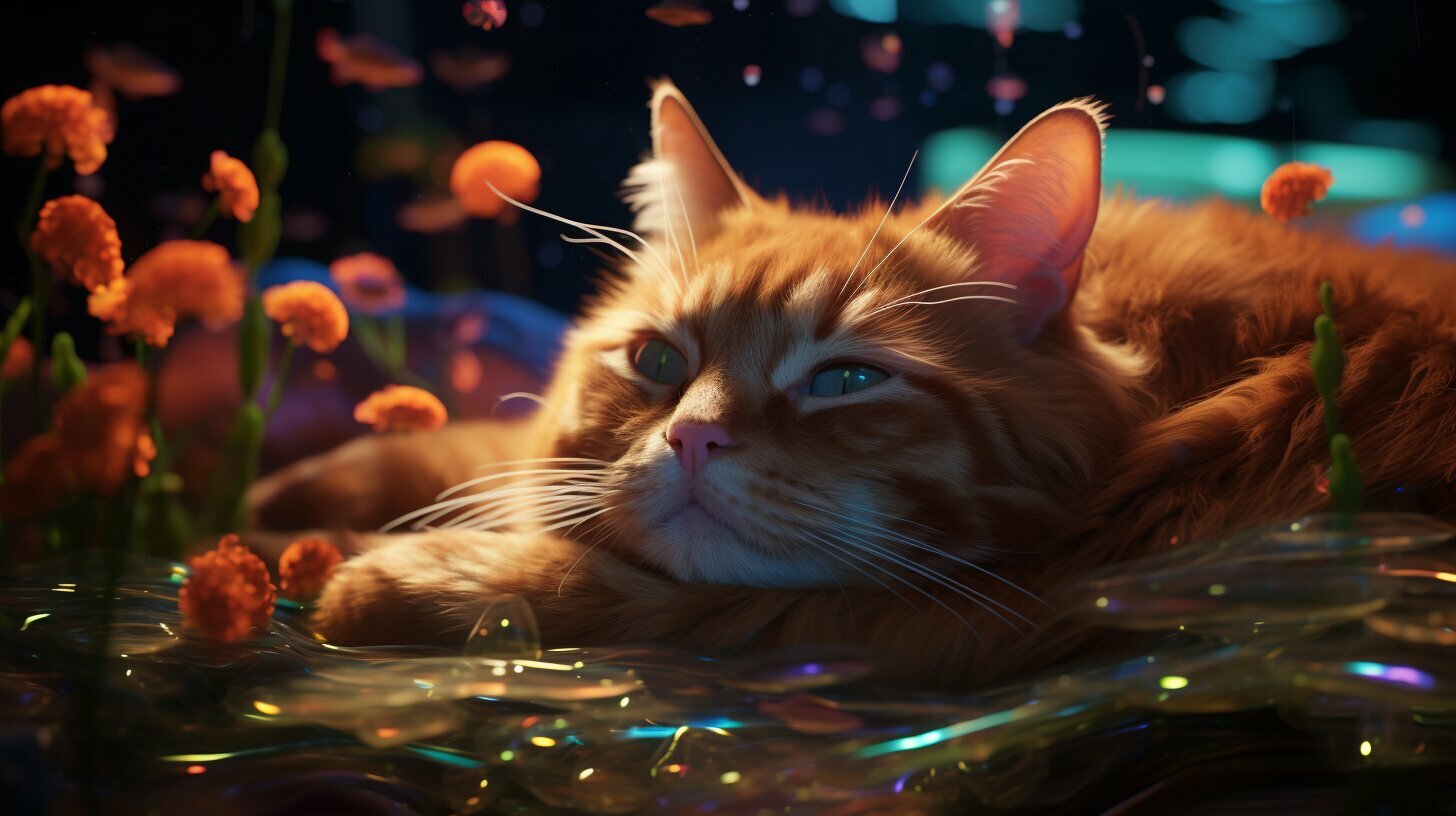As a cat lover, I have often wondered about the mysterious world of feline dreams. Do cats dream like humans do? And more specifically, can they experience lucid dreams, where they have conscious control over their dream state?
Lucid dreaming has long been a topic of interest among human dreamers, who seek to explore the blurred boundaries between the waking and dreaming worlds. In recent years, however, researchers have turned their attention to animal dreaming, including that of our feline friends.
In this article, we will delve into the topic of cats and their dreams, specifically exploring the concept of lucid dreaming in felines. We will examine the typical sleeping and dreaming patterns of cats, discuss whether cats dream consciously or not, and explore the potential signs that indicate a cat may be experiencing lucid dreams.
Key Takeaways:
- Cats’ sleeping and dreaming patterns involve cycles of deep sleep and REM sleep, which is crucial for dreaming.
- Scientific studies have shed light on the question of whether cats dream consciously or not.
- Potential signs that a cat may be experiencing lucid dreams include twitching, vocalizations, and other observable behaviors.
Understanding Cat Dreaming Patterns
Before we explore the concept of lucid dreaming in cats, it’s important to understand their typical sleeping and dreaming patterns. Like humans, cats experience different stages of sleep, with the most important stage for dreaming being the Rapid Eye Movement (REM) stage.
Average cats sleep around 12-16 hours a day, with some even sleeping up to 20 hours. During sleep, cats typically cycle through stages of deep sleep and light sleep, with periods of REM sleep occurring intermittently throughout the night. During REM sleep, cats may twitch, move their limbs, and even vocalize. This is the stage of sleep that is associated with dreaming in both humans and animals.
Interestingly, cats spend much of their time in a light sleep stage, as they are highly alert and ready to react to any potential danger. This is believed to be a trait developed from their ancestors, who were both hunters and prey in the wild.
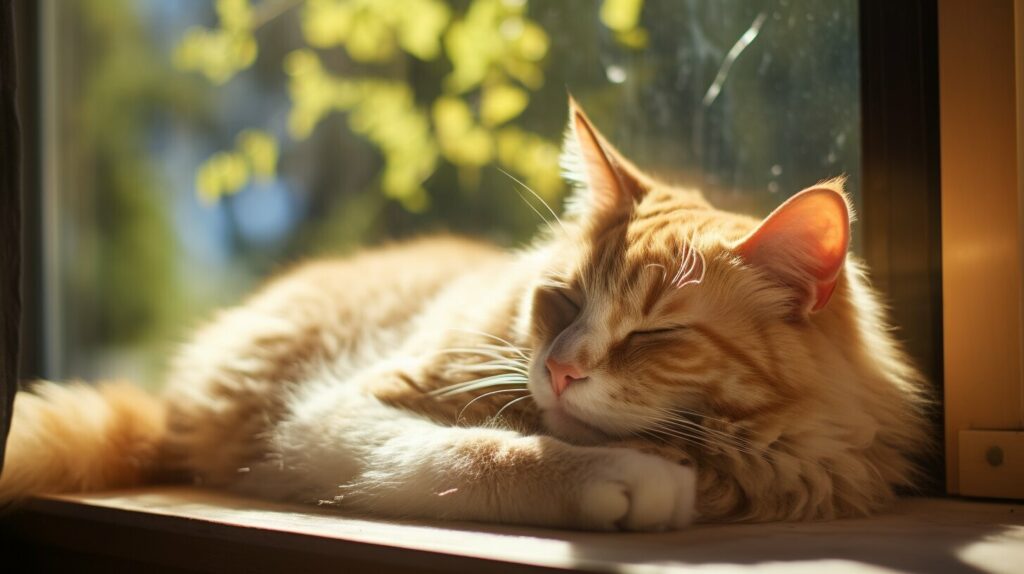
In addition to their sleeping patterns, it’s important to note that cats often dream about things they experience in their waking life. This means that if your cat spends the day playing with toys or stalking birds outside, they may be more likely to dream about these experiences during their REM sleep stage.
REM Sleep in Cats
REM sleep is crucial for dreaming, as it is during this stage that the brain becomes highly active, and dreams are thought to occur. Interestingly, kittens spend the majority of their sleep in the REM stage, while adult cats spend less time in REM and more time in light sleep. This suggests that REM sleep may be more important for brain development and learning in younger cats.
Overall, understanding a cat’s sleep and dreaming patterns is crucial for exploring the concept of lucid dreaming in felines. While we can’t ask our cats about their dreams, observing their behaviors during sleep can provide insight into their dreamworlds. In the next section, we’ll explore the question of whether cats dream consciously or not.
Do Cats Dream Consciously?
One of the most intriguing questions when it comes to cats and their dreams is whether they dream consciously or not. Conscious dreaming refers to the phenomenon of being aware that one is in a dream and being able to control it to some extent. While humans are known to be able to experience lucid dreams, there is much debate about whether cats possess this ability as well.
Research studies on feline dreaming have shed some light on this topic. According to a study published in the Journal of Sleep Research, cats go through four stages of sleep, including REM (Rapid Eye Movement) sleep, which is associated with dreaming in humans. During REM sleep, the brain sends signals to the muscles to immobilize them, preventing the cat from acting out its dreams. This suggests that cats do dream, but whether they do so consciously is still up for debate.

Some experts believe that cats are capable of achieving lucid dreams due to their highly attuned senses and instincts. In the wild, cats rely heavily on their instincts to hunt and survive, and it’s possible that these instincts carry over into their dreams, allowing them to control and manipulate their dream world to some extent.
There have also been anecdotal reports from cat owners who have observed their pets exhibiting behaviors that suggest conscious dreaming, such as moving their paws as if they are chasing something or vocalizing in their sleep. However, without concrete scientific evidence, it’s impossible to say for sure whether these observations are a result of conscious dreaming or something else entirely.
Overall, while there is no conclusive proof that cats experience conscious dreaming, the possibility cannot be ruled out entirely. As our understanding of feline sleep and dreaming continues to evolve, it’s likely that we will gain a better understanding of the complex world of feline dreams.
Signs of Cat Lucid Dreams
So, how can you tell if your feline companion is experiencing lucid dreams? While scientists are still studying this phenomenon, there are some potential signs to look out for:
- Twitching: You may observe your cat’s body twitching, indicating that they are in deep REM sleep, which is when lucid dreaming is most likely to occur.
- Vocalizations: Your cat may make noises while sleeping, such as purring or meowing, which could be a sign of lucid dreaming.
- Movements: If your cat appears to be moving purposefully while sleeping, such as batting at imaginary toys or chasing something, this may indicate that they are having a lucid dream.
It’s important to note that not all cats exhibit these signs while sleeping, and there is still much we don’t know about feline dreaming. However, if you observe any of these behaviors in your cat, it’s possible they are experiencing some form of lucid dreaming.
Next, we will explore the concept of lucidity in cat dreams and whether cats can have conscious control over their dreamworlds.

Exploring Lucidity in Cat Dreams
Lucid dreaming, the ability to be aware that one is dreaming and even have some control over their dreams, is a fascinating aspect of human sleep and consciousness. But can cats experience the same phenomenon? While there is limited research on feline dream consciousness, some scientists and cat owners believe that cats may indeed have lucid dreams.
In order to understand lucidity in cat dreams, it’s important to first define what it means. Lucid dreaming involves a heightened state of cognitive awareness during sleep, allowing the dreamer to recognize that they are in a dream and sometimes even manipulate the dream’s content. While humans have the ability to learn and practice lucid dreaming techniques, such as reality testing and dream journaling, it’s unclear if cats can consciously control their dreams in the same way.
However, there are some observations and behaviors that suggest cats may have some level of lucidity in their dreams. For example, cats may exhibit purposeful movement or vocalization during sleep, indicating that they are actively engaged in their dream. Some cat owners have even reported their feline companions responding to external stimuli while asleep, further supporting the idea of some level of consciousness during dreaming.
Exploring the Science of Feline Dreaming
While there is limited research specifically focused on feline lucid dreams, there is some understanding of how cats sleep and dream. Like humans, cats go through different stages of sleep, including rapid eye movement (REM) sleep, which is when most dreaming occurs. Scientists have studied the brain activity of sleeping cats and have found similarities to human brain activity during REM sleep. This suggests that cats may have similar dream experiences as humans, but it’s unclear how much consciousness is involved in those dreams.
Some scientists believe that lucid dreaming in cats is possible due to their highly developed senses and cognitive abilities. Cats are known for their sharp senses and quick reflexes, and it’s possible that these traits could also play a role in their dream consciousness. However, more research is needed to fully understand the extent of feline dream consciousness, including lucid dreaming.
Can Cats Learn to Lucid Dream?
While there is no scientific evidence to suggest that cats can be trained to lucid dream, some cat owners have reported success in helping their feline friends become more aware during sleep. This may involve engaging in play and training activities during waking hours that encourage cognitive development and awareness, which could potentially carry over into dream consciousness. However, it’s important to note that any attempts to alter a cat’s natural sleep and dreaming patterns should be done with caution and respect for the animal’s well-being.
Overall, the question of whether cats can have lucid dreams remains a subject of curiosity and debate. While there is some evidence to suggest that cats may have some level of consciousness during dreaming, more research is needed to fully understand the extent of feline dream consciousness and whether lucid dreaming is possible for our feline companions.
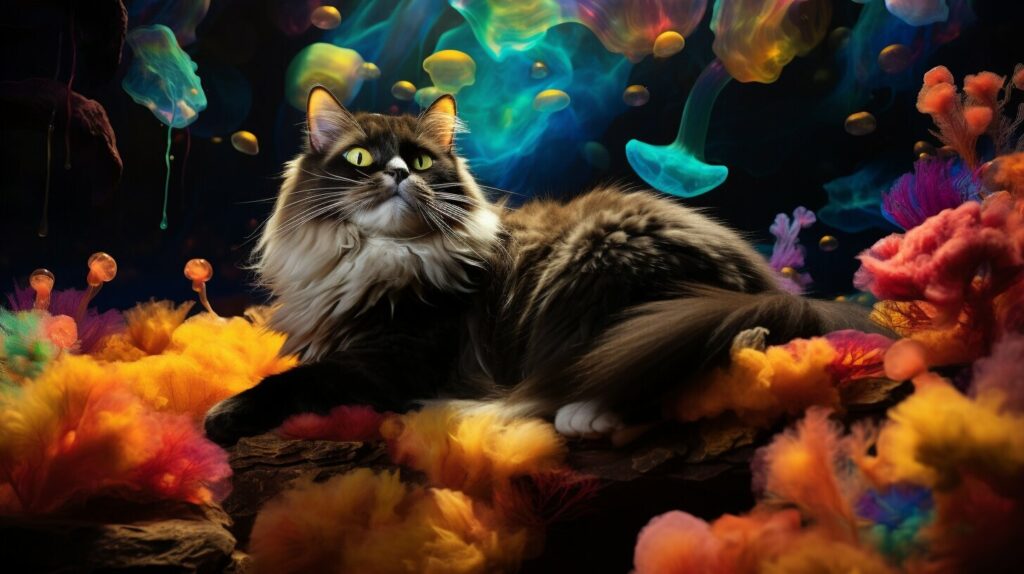
Cat Lucid Dreaming Experiences
As a cat owner and lover, I have witnessed firsthand the curious and intriguing sleeping behaviors of felines. And as someone who is fascinated by the mysteries of the dreaming mind, the idea of cats having lucid dreams has always been a topic of interest for me.
One of the most vivid examples I’ve seen of a cat potentially engaging in lucid dreaming was with my own cat, Whiskers. One night, he was lying on his side, eyes closed, and suddenly began twitching his paws and letting out quiet meows. As I watched, he suddenly sat up, eyes wide open, as if startled. But then, instead of getting up or looking around, he simply lay back down and continued sleeping peacefully. It’s impossible to know for sure, but it certainly seemed like he had been aware of his dream and possibly even had some control over it.
This experience led me to do some research and talk to other cat owners, and I discovered that I was not alone in my observations. Many others have reported similar behaviors in their own cats, such as pawing at invisible objects or even playfully chasing something they see in their dreams.
| Signs of Cat Lucid Dreams | Description |
|---|---|
| Twitching | Cats may twitch their paws or other body parts while dreaming. |
| Vocalizations | Cats may meow, purr, or make other sounds while dreaming. |
| Movements | Cats may move their heads or bodies in response to their dreams. |
While these behaviors are not definitive proof of lucid dreaming in cats, they do suggest that something interesting is going on in their dreamworlds. And given what we know about the complexity of feline brains and their capacity for emotion and memory, it’s certainly not out of the realm of possibility that cats are capable of conscious dreaming.
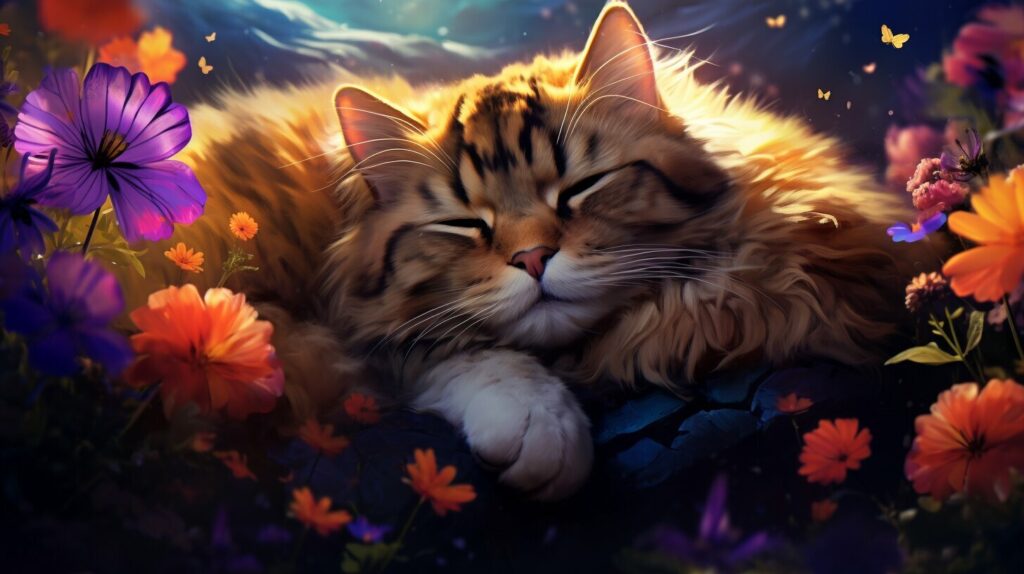
Of course, as with any aspect of animal behavior and cognition, it’s difficult to know for sure what’s going on inside a cat’s mind. But as more research is done and more cat owners share their experiences, we may begin to unlock the secrets of feline lucid dreaming.
How to Tell If Your Cat Is Having Lucid Dreams
If you’re curious about whether your feline friend is experiencing lucid dreams, there are several signs you can look for.
One of the most common indications of lucid dreaming in cats is twitching or jerking movements while they sleep. This can be a sign that they are actively engaged in their dream and may be experiencing a sense of control over their dream world.
Vocalizations are another clue that cats may be having lucid dreams. If your cat is meowing, purring, or making other noises while sleeping, it could be a sign that they are fully immersed in their dreams.
Another behavior to watch for is the movement of their eyes behind their closed eyelids. Rapid eye movement (REM) is a key component of dreaming, and if you see your cat’s eyes darting back and forth while they sleep, it’s a good indication that they are experiencing some form of dream activity.
If your cat is exhibiting any of these signs while sleeping, there’s a good chance that they are experiencing lucid dreams. It’s important to note, however, that not all cats may exhibit these behaviors, and some may be more subtle in their dream activity.
Observing your cat’s sleeping patterns and behaviors can provide valuable insight into their dream life, and can deepen the bond between you and your feline companion.
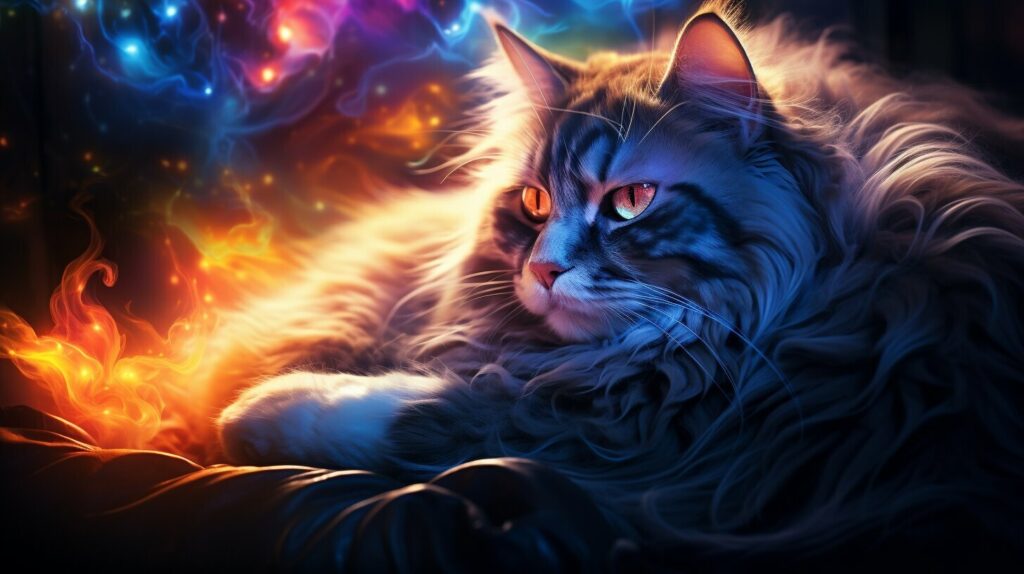
Feline Lucid Dreams: The Science Behind It
While the concept of lucid dreaming in humans has been studied extensively, research on the topic of feline lucid dreams is still in its early stages. However, there is evidence to suggest that cats may indeed experience conscious control over their dreams.
One theory is that cats, like humans, have a prefrontal cortex that is responsible for higher cognitive functions, including self-awareness and decision-making. This region of the brain may also play a role in the ability to control dreams.
In a study published in the journal Behavioral Brain Research, researchers found that cats displayed similar brainwave patterns during sleep as humans do during REM sleep, which is the stage of sleep most closely associated with dreaming. This suggests that cats may experience similar states of consciousness during dreaming as humans do.
| Did You Know? |
|---|
| The average cat spends around 12-16 hours a day sleeping, with kittens often sleeping up to 20 hours! |
Another study, published in the journal Consciousness and Cognition, found that rats, which share many similarities with cats in terms of brain structure and sleep patterns, were able to exhibit lucid dreaming-like behavior in a laboratory setting. The rats were able to recognize they were in a dream state and even showed signs of controlling their dreams.
While this research is still in its early stages, it suggests that there is a possibility that cats may be able to experience lucid dreams and have some control over their dream content. However, further studies are needed to confirm and understand the nature of feline dream consciousness.

“It suggests that there is a possibility that cats may be able to experience lucid dreams and have some control over their dream content.”
Lucid Dreaming in Cats: Myth or Reality?
As with many topics in science, the concept of lucid dreaming in cats has its share of skeptics and doubters. Some experts argue that while cats certainly dream, the idea of them being able to consciously control those dreams is unlikely.
One argument against feline lucid dreaming is based on brain structure. While humans have a highly developed prefrontal cortex that is associated with self-awareness and decision-making, cats have a much less developed version of this brain region. Without this level of mental capacity, some experts believe that conscious dreaming is simply not possible for cats.
On the other hand, many cat owners and enthusiasts argue that they have observed their pets exhibiting signs of lucid dreaming, such as twitching or making noises during sleep that appear to indicate conscious participation in their dream state. Additionally, some experts speculate that while cats may not have the same level of cognitive ability as humans, they may still be capable of experiencing a form of lucid dreaming.
Ultimately, the question of feline lucid dreaming remains a topic of debate within the scientific community. While studies have provided some evidence to support the idea, there is still much to learn about how and why cats dream, and whether they are capable of conscious control over those dreams.
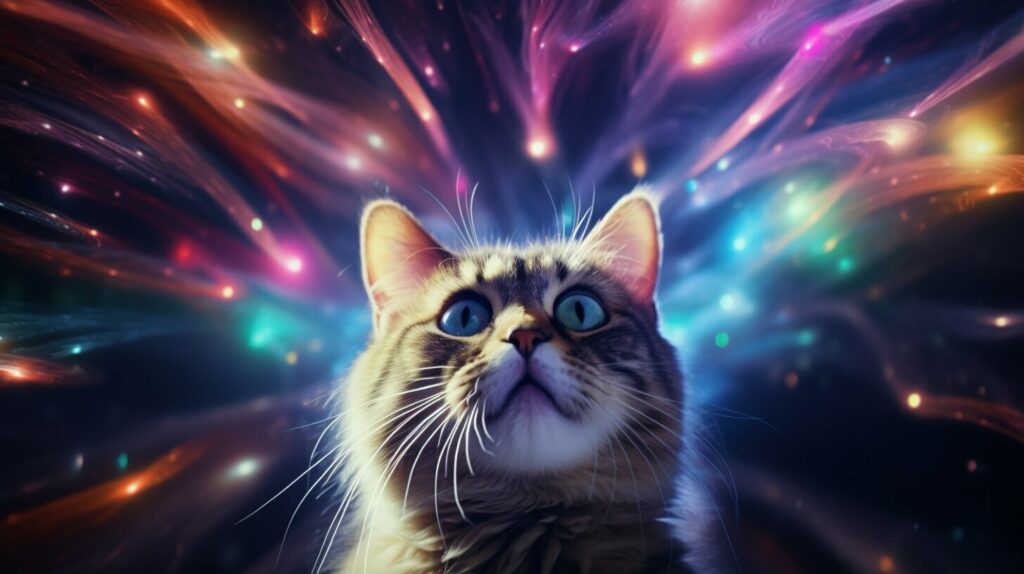
Despite the uncertainty surrounding this topic, the idea of cats and their dreams is still a fascinating one. By observing our feline friends as they sleep and dream, we may be able to gain new insights into the mysterious inner worlds of these beloved pets.
Conclusion
After exploring the world of feline dreams and the concept of lucid dreaming in cats, it is clear that there is still much to learn and understand. While scientific studies show that cats likely do dream, the extent to which they can control and participate in those dreams is still up for debate.
As pet owners, we can observe our cats’ behaviors during sleep to gain insight into their dream experiences. Whether it’s twitching, vocalizations, or other signs, these behaviors can provide a glimpse into the mysterious world of feline dreaming.
While skeptics may doubt the existence of cat lucid dreaming, anecdotal experiences from cat owners suggest otherwise. There is no doubt that cats have complex and fascinating inner lives, and their dreams are a part of that.
In conclusion, the topic of cats and lucid dreaming is a fascinating one that continues to capture the curiosity of pet owners and scientists alike. While much remains to be discovered about the consciousness of feline dreams, it is clear that our furry friends are capable of complex and vivid dream experiences.
FAQ
Q: Can cats have lucid dreams?
A: Yes, cats can have lucid dreams. Lucid dreaming refers to the state of being aware that one is dreaming while the dream is still ongoing. While it is difficult to measure or confirm whether cats are aware of their dreams, there are observable behaviors that suggest they may experience lucidity during their sleep.
Q: What are the signs of cat lucid dreams?
A: Signs of cat lucid dreams can include twitching, vocalizations, rapid eye movements, paw movements, and changes in breathing patterns. These behaviors may indicate that the cat is engaging in interactive dreaming, where they are actively participating in and experiencing their dreams.
Q: How can I tell if my cat is having lucid dreams?
A: To determine if your cat is having lucid dreams, you can observe their sleep behavior for signs of twitching, vocalizations, and rapid eye movements. You may also notice changes in their body posture or muscle tension during sleep. Keeping a sleep diary and discussing any observed behaviors with a veterinarian can help in evaluating whether your cat is experiencing lucid dreams.
Q: Is there scientific evidence of cat lucid dreaming?
A: While there isn’t definitive scientific evidence to prove that cats have lucid dreams, studies on animals’ sleep patterns and dreaming suggest that it is possible. Researchers have observed similar brain patterns during REM sleep in cats and humans, the sleep stage associated with vivid dreams and potential lucidity. However, more research is needed to fully understand the extent of feline dreaming capabilities.
Q: Are cats consciously aware of their dreams?
A: The exact level of conscious awareness that cats have in their dreams is still not fully understood. While cats exhibit behaviors during sleep that suggest they may have some level of awareness, it is challenging to measure their subjective experience. Further research is necessary to determine the extent of their conscious involvement in dreams.
Q: Are lucid dreams in cats a myth or reality?
A: The existence of lucid dreams in cats is a topic of ongoing debate and research. While there is evidence suggesting that cats may experience some form of lucidity during their dreams, the exact nature and extent of their experience remain uncertain. Different theories and opinions exist among experts, and the scientific community is still exploring this fascinating subject.

